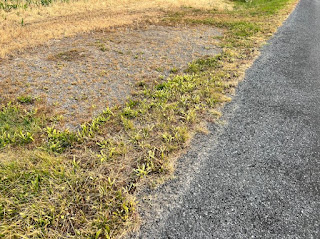Image: Herbicide damage - (The bleaching shown on the grass in the picture above is evidence of herbicide damage surrounding a nearby field of corn located on the Wye property to prevent interspecies competition and lower overall crop yield.)
In University, at the beginning of each course taken there is always the promise of connecting the topics so dutifully learned in class with the potential to interrelate them into more practical experiences in the workforce. Experiencing that coming to fruition under the umbrella of weed science is a hallmark of the benefits of class based learning. Whether relating organic chemistry to the basics of pesticide functionality or biology to basic weed physiology, it is stimulating to be able to apply some of the knowledge I have gleaned over the course of the past few years into an applied field. Working under the guidance of such a knowledgeable and passionate expert, however, has gone to show me how little I truly know and reminded me of my own passion for knowledge.
Despite calculus being tangentially related to the math behind sprayer calibration, working with extension is a wonderful example of the parallels between practical experience and rigorous research methods. This juxtaposition is most evident on a daily basis as one hour may be spent learning how to use ARM software for data analysis and the next entails flame weeding all followed by time in the field learning how to rate weed density qualitatively. I never realized how much I wanted to know until I realized I knew very little. My goal for this internship is not, like many others, to add another notch on my resume. My goal is to absorb as much knowledge over the course of the few weeks I have remaining and utilize the skills I learn here into my studies at University, research, and into whatever career I move onto next.
My knowledge may not be as extensive as Dr. Vollmers, weeds science or otherwise, as would be expected. If I am able to retain even a fraction (although I hope more) of what Dr. Vollmer has shown me previously and over the course of the upcoming few weeks, however, I know that not only would my career benefit but I as a person as well.
Image: Osprey Nest - (An osprey can be seen protecting her nest on a pole custom built to prevent nesting on neighboring power lines near the research fields. When walking past, she often circles above to assess any threat to her brood until well past. Her nest is evidence of the plethora of wildlife surrounding and on the extensive property.)

.JPG)
This comment has been removed by a blog administrator.
ReplyDelete